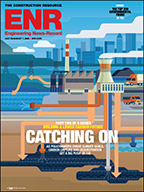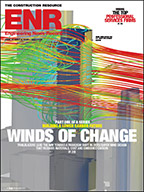Scientists from the National Academies of Sciences, Engineering and Medicine say negative emissions technologies that remove carbon dioxide directly from ambient air or which enhance natural carbon sinks could be scaled up to capture and store a significant amount of global carbon emissions, but not enough to ensure global temperature don't rise more than 2° C. As a result, more research is needed to understand how to overcome the existing constraints on the technologies, such as high costs and energy requirements.
In an NAS report released Oct. 24, the scientists say a substantial research initiative should begin as soon as possible to learn more about the impacts, limitations, and scalability of negative emissions technologies (NETs).
At briefing on the report, Stephen Pacala, a Princeton University professor and chairman of the committee that wrote the report, says NETs are essential to offset CO2 emissions. “NETs should be viewed as part of the mitigation tool kit,” he said. Moreover, “if we want to get back to [a 0° increase in global temperatures], the only way to do it is with NETs.”
Because they remove CO2 directly from the air, NETs differ from traditional carbon capture and storage (CCS) technologies, which remove CO2 from large point sources such as coal powerplants. According to NAS, storing CO2 from NETs has the same impact as preventing the same amount of emissions from occurring at all.
The report was sponsored by the Energy Department, the U.S. Environmental Protection Agency, and other government agencies, as well as several private foundations and non-profits.
Four land-based NETs—reforestation, changes in forest management, changes in agricultural practices to enhance soil carbon storage, and using biomass, rather than fossil fuels, to produce electricity with CCS—are ready for cost-effective large-scale deployment, but they all have limitations that could cause environmental or societal harm. For example, to produce the biomass needed for a CCS plant could reduce the amount of crops grown for food, Pacala said. Research could identify ways to develop crops that take up and sequester carbon more efficiently in soils.
Other NETs include enhancing the amount of carbon stored in coastal ecosystems. Although this NET has limited capacity to remove CO2, Its cost is so low, that it would be very easy “for the Army Corps to add blue carbon” as a consideration in coastal projects, Pacala said.
Two other NETs carry enormous potential, the report says. Direct air capture uses chemical processes to snatch CO2 directly from the air, concentrate it, then sequester it in a storage reservoir. Carbon mineralization accelerates the process by which CO2 from the atmosphere chemically bonds with reactive minerals. Both of these technologies are still in the embryonic stages, however, with either too high a cost, or too little understanding, to be currently effective, he says.
That could change within a decade, though, with government agency support, or through public-private partnerships that encourage start-ups to study, test, and develop these technologies, Pacala said.
In addition to mitigating the effects of climate change, NETs could open up a huge untapped market. The question for U.S. agencies, business and engineering firms, according to Pacala is: “These sorts of technologies are going to become a big market. Are U.S. companies going to benefit or not?”
Addison Stark, associate director for energy innovation at the Bipartisan Policy Center, agreed. "While the challenge may seem daunting, companies around the world are already demonstrating that carbon removal and direct air capture technology works. With strong research investment in key areas that today’s report outlines, the United States is well-poised to pioneer breakthroughs that reduce carbon pollution and reassert our global technology leadership.”






Post a comment to this article
Report Abusive Comment